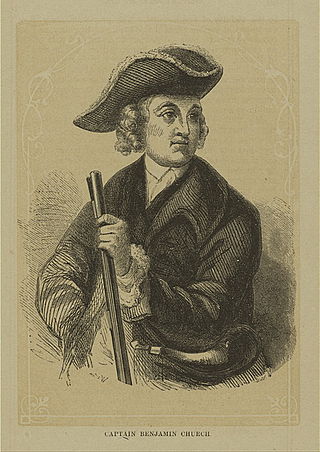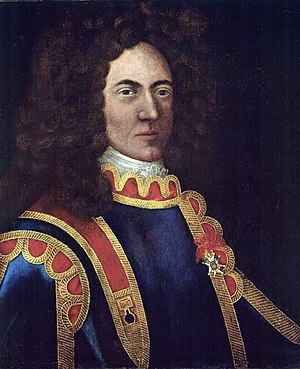
Queen Anne's War (1702–1713) was the second in a series of French and Indian Wars fought in North America involving the colonial empires of Great Britain, France, and Spain; it took place during the reign of Anne, Queen of Great Britain. In the United States, it is regarded as a standalone conflict under this name. Elsewhere it is usually viewed as the American theater of the War of the Spanish Succession. It is also known as the Third Indian War. In France it was known as the Second Intercolonial War.

King William's War was the North American theater of the Nine Years' War (1688–1697), also known as the War of the Grand Alliance or the War of the League of Augsburg. It was the first of six colonial wars fought between New France and New England along with their respective Native allies before France ceded its remaining mainland territories in North America east of the Mississippi River in 1763.

Colonel Benjamin Church was an American military officer and politician who is best known for his role in developing military tactics and participating in numerous conflicts which involved the New England Colonies. He is also known for commanding one of the first ranger units in North America. Born in the Plymouth Colony, Church was commissioned by Governor Josiah Winslow to establish a company of rangers after the outbreak of King Philip's War in 1675. A force of New Englanders led by him was responsible for tracking down and killing Wampanoag sachem Metacomet, which played a major role in ending the conflict.

Dummer's War (1722–1725) was a series of battles between the New England Colonies and the Wabanaki Confederacy, who were allied with New France. The eastern theater of the war was located primarily along the border between New England and Acadia in Maine, as well as in Nova Scotia; the western theater was located in northern Massachusetts and Vermont at the border between Canada and New England. During this time, Maine and Vermont were part of Massachusetts.

The Raid on Deerfield, also known as the Deerfield Massacre, occurred during Queen Anne's War on February 29, 1704, when French and Native American raiders under the command of Jean-Baptiste Hertel de Rouville attacked the English colonial settlement of Deerfield, Massachusetts, just before dawn. They burned parts of the town and killed 47 colonists. The raiders left with 112 colonists as captives, whom they took overland the nearly 300 miles to Montreal; some died or were killed along the way because they were unable keep up. Roughly 60 colonists were later ransomed by their associates, while others were adopted by Mohawk families at Kahnawake and became assimilated into the tribe. In this period, English colonists and their Indian allies were involved in similar raids against French villages along the northern area between the spheres of influence.

Odanak is an Abenaki First Nations reserve in the Central Quebec region, Quebec, Canada. The mostly First Nations population as of the Canada 2021 Census was 481. The territory is located near the mouth of the Saint-François River at its confluence with the St. Lawrence River. It is partly within the limits of Pierreville and across the river from Saint-François-du-Lac. Odanak is an Abenaki word meaning "in the village".
Eunice Williams, also known as Marguerite Kanenstenhawi Arosen, was an English colonist taken captive by French and Mohawk warriors from Deerfield, Massachusetts in 1704. Taken to Canada with more than 100 other captives, the seven-year-old girl was adopted by a recently converted Mohawk family at Kahnawake and fully assimilated into Mohawk society. She was baptized as the Catholic "Marguerite" and renamed A'ongonte, meaning "she who has been planted as an ash tree." She eventually married a Mohawk man, François-Xavier Arosen, having several children and remaining with the Mohawk for the rest of her life. While choosing not to return to her natal family, she, along with her children, repeatedly made the trek to Deerfield to visit with her Puritan siblings over the course of her life. Her father, Rev. John Williams and her brother Samuel made numerous efforts to ransom her to no avail. Moreover, they failed to persuade her to return to Massachusetts and her birth family.

The siege of Port Royal in 1707 included two separate attempts by English colonists from New England to conquer Acadia by capturing its capital Port Royal during Queen Anne's War. Both attempts were made by colonial militia, and were led by men inexperienced in siege warfare. Led by Acadian Governor Daniel d'Auger de Subercase, the French troops at Port Royal easily withstood both attempts, assisted by irregular Acadians and the Wabanaki Confederacy outside the fort.

John Williams was a New England Puritan minister who was the noted pastor of Deerfield from 1688 to his death. He and most of his family were taken captive in the Raid on Deerfield in 1704 during Queen Anne's War. He was held by the French in Montreal for more than two years, who wanted a high-ranking French pirate in exchange. After being released in late 1706, Williams became even more notable for The Redeemed Captive (1707), his account of his captivity. It became a well-known work in the genre of captivity narratives.

The Raid on Grand Pré was the major action of a raiding expedition conducted by the New England militia Colonel Benjamin Church against French Acadia in June 1704, during Queen Anne's War. The expedition was allegedly in retaliation for a French and Indian raid against the Massachusetts frontier community of Deerfield earlier that year.

Jean-Baptiste Hertel de Rouville was a colonial military officer of New France in the French Marines in Canada. He is best known in North America for leading the raid on Deerfield, in western Province of Massachusetts Bay, against English settlers on 29 February 1704 during Queen Anne's War.
The military history of Vermont covers the military history of the American state of Vermont, as part of French colonial America; as part of Massachusetts, New Hampshire and New York during the British colonial period and during the French and Indian Wars; as the independent New Connecticut and later Vermont during the American Revolution; and as a state during the War of 1812 and the American Civil War.
Fort Ste. Anne is a former French military fort located at present-day Englishtown, Nova Scotia, on the Island of Cape Breton, Nova Scotia, Canada.

The Raid on Salmon Falls involved Joseph-François Hertel de la Fresnière, along with Norridgewock Abnaki chief Wahowa, and possibly Maliseet Abnaki war chief Assacumbuit, leading his troops as well as the Wabanaki Confederacy in New Brunswick to capture and destroy an English settlement of Salmon Falls during King William's War.
The Northeast Coast campaign was the first major campaign by the French of Queen Anne's War in New England. Alexandre Leneuf de La Vallière de Beaubassin led 500 troops made up of French colonial forces and the Wabanaki Confederacy of Acadia. They attacked English settlements on the coast of present-day Maine between Wells and Casco Bay, burning more than 15 leagues of New England country and killing or capturing more than 150 people. The English colonists protected some of their settlements, but a number of others were destroyed and abandoned. Historian Samuel Drake reported that, "Maine had nearly received her death-blow" as a result of the campaign.
The Raid on Haverhill was a military engagement that took place on March 15, 1697 during King William's War. Ordered by Louis de Buade de Frontenac, Governor General of New France, French, Algonquin, and Abenaki warriors descended on Haverhill, then a small frontier community in the Province of Massachusetts Bay. In the surprise attack, the Abenaki killed 27 colonists and took 13 captive. The natives burned six homes. The raid became famous in the nineteenth century because of Hannah Dustin's captivity narrative as a result of the raid.

The Maliseet militia was made up of warriors from the Maliseet of northeastern North America. Along with the Wabanaki Confederacy, the French and Acadian militia, the Maliseet fought the British through six wars over a period of 75 years. They also mobilized against the British in the American Revolution. After confederation, Maliseet warriors eventually joined Canada's war efforts in World War I and World War II.
Rebecca Kellogg Ashley was an English child captured by allied French, Canadian militia, Iroquois, and Algonquin soldiers in the 1704 Deerfield Raid. The Deerfield attack was part of the decade-long Queen Anne's War. Rebecca was eight years old. Eunice Williams was captured in this same raid, as was her father, John Williams who wrote about his captive experience in The Redeemed Captive. Like Eunice and several other children from Deerfield, Rebecca Kellogg was adopted by Haudenosaunee Mohawks in the town of Kahnawake. She married and she raised children.
The Battle of Falmouth was fought at Falmouth, Maine when the Canadiens and Wabanaki Confederacy attacked the English New Casco Fort. The battle was part of the Northeast Coast Campaign (1703) during Queen Anne's War.
Elizabeth Mary Sadoques Mason was one of the first Native American Registered Nurses known in United States. Though not much is known about her career, Elizabeth finished nursing school in New York in 1919 and worked as a nurse to artist Abbot Handerson Thayer.











